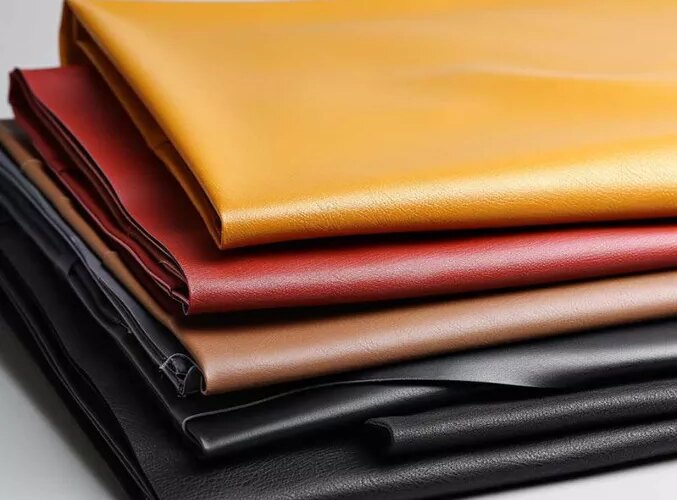What is PU leather?
PU leather, also known as Polyurethane leather, is a popular synthetic material used in fashion, accessories, and furniture for its affordability.
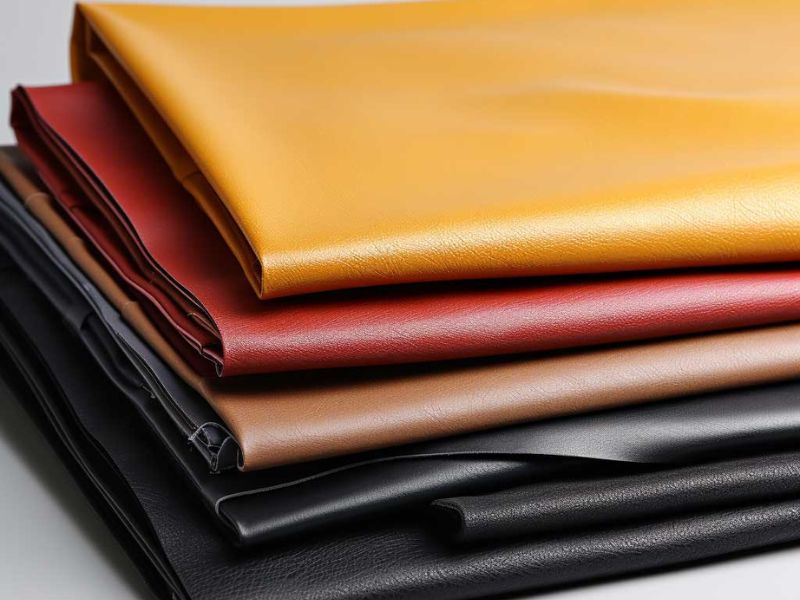
The concept of PU leather refers to a type of synthetic leather material that is manufactured to resemble real leather. PU stands for polyurethane, which is a polymer that is commonly used in the production of various products. PU leather is designed to replicate the appearance and texture of genuine leather, but at a more affordable price point. It is composed of a layer of fabric or foam that is coated with a polyurethane finish, giving it a smooth and glossy surface. PU leather is commonly used in the production of clothing, shoes, handbags, furniture upholstery, and other consumer goods. It offers advantages such as being more durable, easier to maintain, and more resistant to water and stains compared to genuine leather. While it may not possess the same level of breathability or aging characteristics as real leather, PU leather provides a cost-effective alternative for those who desire the look and feel of leather without the higher price tag.
What are the remarkable benefits of PU leather?
PU leather, also known as polyurethane leather, is a highly versatile material that finds extensive applications across various industries. This is primarily due to its exceptional properties and benefits. Users who have extensively used PU leather have enthusiastically shared their positive experiences, highlighting the following remarkable advantages:
1. Durability: PU leather is renowned for its durability, ensuring long-lasting performance. It withstands everyday wear and tear with ease, making it ideal for items that are heavily used or subject to frequent handling.
2. Versatility: PU leather is adaptable and can be manufactured in a wide range of colors, textures, and finishes. This allows for endless design possibilities while ensuring it can suit diverse aesthetic preferences and applications.
3. Cost-effectiveness: In comparison to genuine leather, PU leather is often more affordable, making it a cost-effective alternative. It offers a luxurious look and feel without the high price tag, making it highly desirable for budget-conscious consumers.
4. Ease of maintenance: PU leather is relatively easy to clean and maintain, requiring minimal effort. It resists stains, spills, and fading, making it an excellent choice for high-traffic areas or products prone to dirt or spills.
5. Animal-friendly: As a synthetic material, PU leather does not involve the use of animal products or harm animals in its production. This attribute appeals to individuals who prioritize ethical and sustainable choices.
6. Water resistance: PU leather exhibits excellent water resistance properties, making it suitable for applications where exposure to moisture is expected. It repels water, preventing it from seeping into the material and causing damage or deformation.
7. Consistency: PU leather offers consistent quality and appearance. This uniformity ensures that products made from PU leather maintain their aesthetic appeal, avoiding any inconsistencies that may be found in genuine leather.
8. Environmental sustainability: PU leather production techniques have evolved to minimize environmental impact. Many manufacturers employ eco-friendly processes and materials, making PU leather a greener choice than traditional leather.
Overall, these exceptional advantages demonstrate why PU leather has gained popularity across various industries. Its durability, versatility, affordability, low maintenance, animal-friendliness, water resistance, consistency, and environmental sustainability make it an attractive option for manufacturers and consumers alike.
- The price of leather is much cheaper than real leather, even only ¼ of the price of products made from animal skin.
- High quality PU leather Ensures durability, beauty and smoothness over time.
- The leather surface is easy to clean when there are stains. You almost only need to use filtered water or specialized detergent to clean.
- PU leather is completely waterproof. When you walk in the rain or accidentally spill water on the shirt, the inner layer will not get wet.
- From the original large PU leather sheet, it can be easily cut into small pieces and processed to create products of different shapes.
- The ability to color and dye PU leather is simple, the ability to color is relatively standard compared to the desired color. Therefore, you can create PU leather pieces with full colors according to the color chart.
- Using PU leather is contributing to protecting the natural world, preventing the risk of extinction of some species due to illegal hunting for leather.
- PU leather does not dry out over time. Therefore, you do not need to moisturize, just polish to maintain its beauty.
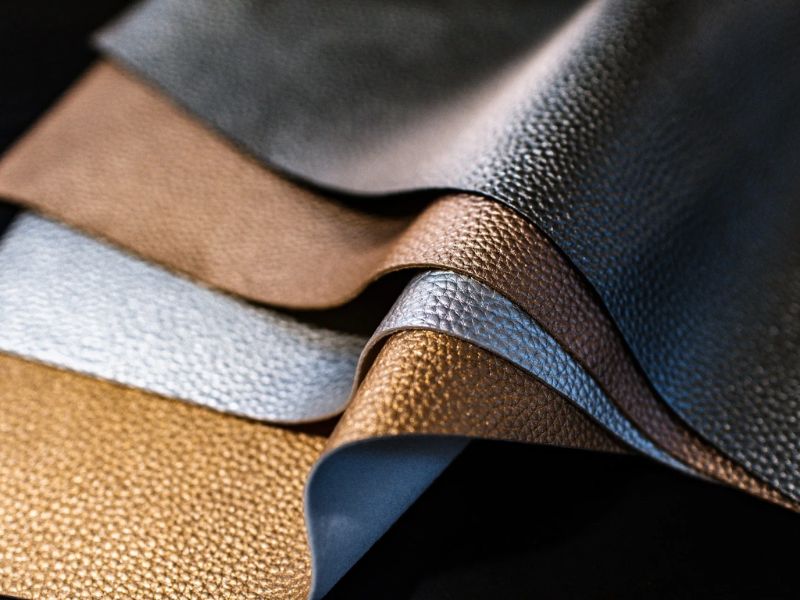
What are some notable advantages of PU leather?
What are the common fields where PU leather is typically utilized?
Polyurethane (PU) leather, also known as vegan leather, is a synthetic leather substitute that is widely utilized across various industries. PU leather offers an alternative to genuine leather, making it a popular choice in numerous fields including: fashion, upholstery, automotive upholstery, footwear, accessories, and furniture manufacturing, among others. Its versatility and durability make it a preferred material for creating a wide range of products.
- In the fashion industry, PU leather is used to produce leather jackets, male pants leather materials, leather accessories such as leather shoes, belt leather, leather wallet.
- PU leather is used for home interior accessories such as sofas, leather cushioned chairs, leather upholstered beds, etc.
- Used in interior design of cars, airplanes, boats and other vehicles.
- Make office accessories like leather chairs.

What are some practical uses or applications of polyurethane (PU) leather?
What sets genuine leather apart from PU leather?
PU leather, also known as artificial leather or industrial leather, and genuine leather, which is derived from animal hide, are two distinct types of leather materials. While both may have a similar appearance, there are significant differences between the two.
In terms of durability, genuine leather tends to be more long-lasting and resistant to wear and tear compared to PU leather. Genuine leather can withstand years of use without showing signs of damage, making it a preferred choice for products that require durability.
In terms of texture, genuine leather has a natural feel and texture due to the genuine animal hide it is made from. On the other hand, PU leather is manufactured and therefore tends to have a more uniform and consistent texture.
Breathability is another factor to consider. Genuine leather allows air to pass through, making it more breathable and comfortable to wear, particularly in hot climates. PU leather, on the other hand, may not provide the same level of breathability and can cause discomfort when worn for extended periods.
When it comes to maintenance, genuine leather requires regular care to maintain its natural texture and appearance. It may need to be conditioned and polished periodically to prevent drying and cracking. PU leather, on the other hand, is typically easier to clean and maintain, requiring minimal effort.
One of the main differences between the two types of leather is their price. Genuine leather tends to be more expensive due to the use of natural resources and the time-consuming process of producing it. PU leather, being a synthetic material, is generally more affordable.
Overall, the choice between PU leather and genuine leather depends on individual preferences and the intended use of the product. While genuine leather offers superior quality and durability, PU leather provides affordability and ease of maintenance.
|
The term “criteria” refers to a set of guidelines, qualifications, or standards that are used to evaluate or assess something. These criteria are established based on specific requirements, objectives, or preferences in order to make informed judgments or decisions. They provide a framework or benchmark against which something can be measured or compared. Criteria help ensure objectivity, consistency, and fairness in evaluations and enable individuals or organizations to make well-informed choices or selections. They can vary depending on the context, such as academic criteria for grading assignments, professional criteria for hiring employees, or quality criteria for assessing products or services. Overall, criteria play a crucial role in various aspects of decision-making and evaluation processes. |
PU leather, also known as polyurethane leather, is a synthetic material that imitates the appearance and texture of genuine leather. It is made by applying a layer of polyurethane to a fabric base, which is then treated and dyed to resemble the natural grain and color of leather. PU leather is commonly used in the production of various products, including furniture, clothing, shoes, handbags, and upholstery. It is valued for its affordability, durability, and versatility, making it a popular alternative to real leather. Additionally, PU leather is considered more environmentally friendly than genuine leather, as it does not involve the use of animal hides. |
Real animal skin refers to the actual hide or pelt of an animal that has been removed and processed for various purposes, such as making leather products or fur garments. This natural material comes from animals like cows, sheep, pigs, rabbits, or exotic animals like snakes or alligators. It is obtained through a process called tanning, which involves treating the skin to make it durable, flexible, and resistant to decay. Real animal skin is often used in the fashion industry to create luxurious leather goods, including shoes, handbags, jackets, and accessories, as well as for the production of fur coats and trimmings. |
|
The word “thickness” refers to the measure of the distance between opposite sides or surfaces of an object or material. It indicates how thick or thin something is, typically measured in units such as inches, millimeters, or centimeters. |
PU leather can be manufactured in varying thicknesses, offering users the flexibility to choose the thickness that best suits their needs. |
The skin of various animals typically has a consistent thickness. |
|
The ability to keep warm refers to the capacity of an individual or object to maintain a comfortable and suitable body temperature, even when exposed to cold or chilly conditions. This ability is essential for survival and wellbeing, as it helps prevent hypothermia, frostbite, and other adverse effects of extreme cold. It involves various physiological mechanisms such as thermoregulation, insulation, and heat production, which collectively work together to maintain an optimal internal body temperature. Additionally, external factors like clothing, shelter, and access to heat sources also play a crucial role in facilitating the ability to keep warm. |
PU leather, also known as polyurethane leather, possesses a lower heat retention capacity compared to genuine leather. In order to enhance its warmth, manufacturers have the option to incorporate complementary materials like fur and felt into the production process. By combining these additional components with PU leather, the resulting product can provide increased insulation and heat retention. |
The item has a relatively high level of heat retention, meaning it is capable of maintaining heat for extended periods of time. |
|
The scent of leather permeates the air, filling the room with its distinct aroma. |
The product emits a distinct odor that can be described as having a chemical or plastic smell. This smell is present due to the fact that the product is manufactured using synthetic polymers. |
Genuine leather undergoes a thorough tanning process that effectively eliminates any unpleasant odors. As a result, genuine leather is typically devoid of any smell. |
|
The term “skin surface” refers to the outermost layer of the skin that covers the body. This layer acts as a protective barrier and is made up of multiple layers of cells. The skin surface plays a crucial role in maintaining the body’s overall integrity by preventing the entry of harmful substances and microorganisms. It also helps regulate body temperature and plays a role in the sensation of touch. Additionally, the skin surface is responsible for various physiological functions such as the synthesis of vitamin D and the elimination of waste products through sweat glands. Overall, the skin surface is an essential component of the body’s first line of defense and plays a significant role in maintaining overall health and well-being. |
The leather surface offers a wide range of design possibilities, allowing for the creation of various patterns based on individual preferences and requirements.
The lines on the skin are consistently even and seem to follow a somewhat predictable pattern.
As time goes by, leather loses its shine and softness, resulting in a dull and less supple appearance. |
As real leather is used over time and receives proper care, it gradually becomes softer and smoother. This is a result of the material undergoing a natural aging process that enhances its texture. The longer leather is used and maintained, the more it develops a luxurious and supple feel. With regular care and attention, the leather’s surface gradually transforms, creating a more pleasant tactile experience.
If you fail to moisturize your skin, it can result in the development of dry skin. |
|
Price can be defined as the amount of money or value that is assigned or charged for a product, service, or commodity. It reflects the monetary worth that customers must pay in order to acquire or obtain the desired item. The price is often determined by various factors such as production costs, market demand, competition, and profit margin. It plays a significant role in the buying decision process and can greatly impact the success and profitability of a business. |
The cost of PU leather products is significantly lower compared to genuine leather. In fact, clothes made from PU leather can be priced at only 25% of the value of clothing made from animal leather, even if they are of the same model. |
The item retains its high value even after being used for a considerable period of time. |
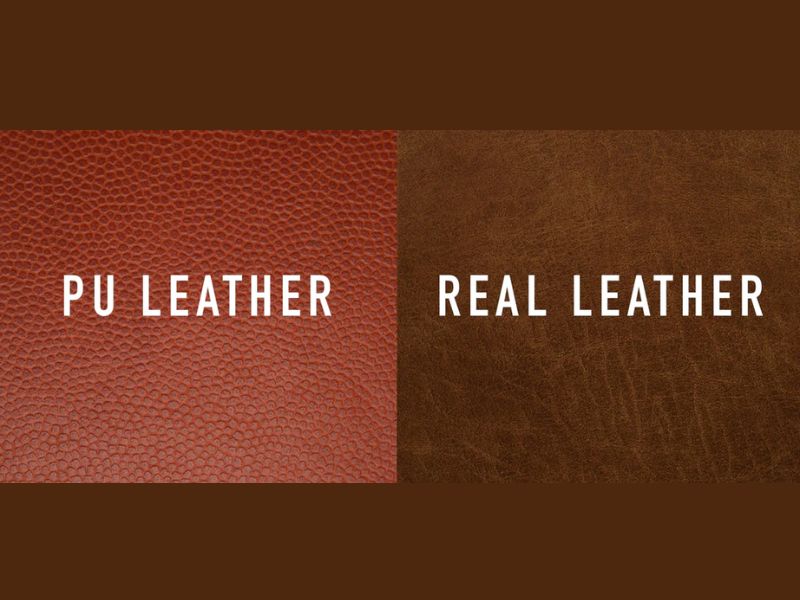
What are the distinguishing characteristics and properties that differentiate genuine leather from PU leather?
How much is PU leather?
The price of PU leather varies depending on the type of product. Users often inquire about the cost of PU leather products. The pricing can be categorized as follows:
- PU leather jackets cost from 500,000 VND – 1,200,000 VND.
- PU leather pants cost from 500,000 VND – 1,000,000 VND.
- PU leather dining room chairs range in price from 700,000 VND – 2,000,000 VND.
What causes PU leather to deteriorate? Tips for maintaining and preserving your PU leather items.
Does PU leather have the tendency to explode? This particular material can develop surface faults or deformities during use, resulting in a loss of its aesthetic appeal. The reasons behind the peeling of PU leather over time may include:
- Poor quality PU leather. This may be due to non-standard materials and outdated production technology.
- Hanging clothes in places that are too hot or too cold will cause the clothes to expand and contract. The bonds of the clothes will then break during the process of returning to normal temperature.
- Hanging clothes in places with too much humidity will cause the product to become water-permeable over time.
- Because you pull the shirt too hard, it loses its elasticity and breaks the fiber structure.
- PU leather surface peels due to continuous friction during use.
- You use inappropriate cleaning chemicals when cleaning leather products.

To effectively preserve PU leather, follow these guidelines:
1. Clean regularly: Wipe the PU leather with a soft, damp cloth to remove dust and dirt. Avoid using harsh chemicals or abrasive materials that may damage the surface.
2. Avoid excessive moisture: PU leather is not resistant to water, so it’s important to protect it from excessive moisture. If it gets wet, gently blot the area with a dry cloth and allow it to air dry. Do not use a hairdryer or direct heat source, as it can cause the material to crack or warp.
3. Keep away from direct sunlight: Prolonged exposure to sunlight can cause PU leather to fade and deteriorate. Place the item out of direct sunlight or use curtains or blinds to shield it from UV rays.
4. Use a conditioner: Apply a specialized PU leather conditioner or a small amount of mild, pH-neutral soap mixed with water to a clean, soft cloth. Gently massage the conditioner onto the leather surface in circular motions to moisturize and maintain its suppleness. Wipe off any excess conditioner with a dry cloth.
5. Prevent sharp objects: Avoid placing sharp objects on or near PU leather, as they may scratch or tear the surface. Place protective pads or mats on furniture or use coasters to prevent damage from glasses or bottles.
6. Store properly: When not in use, store PU leather items in a cool, dry place. Use dust covers or breathable storage bags to protect them from dust, moisture, and potential scratches.
By following these steps, you can extend the lifespan and maintain the appearance of your PU leather items for years to come.
Due to various factors that can cause the surface of PU leather to peel, Fashion Bandung provides helpful tips for effectively preserving PU leather products. These tips aim to prevent explosions and maintain the product’s longevity.
- Limit impact force from all directions on leather products.
- You should not put sharp objects such as knives, scissors, etc. or stab these objects into the leather surface.
- Train pets such as dogs and cats not to scratch randomly on clothes, seat cushions, and leather seats.
- Clean PU leather products periodically with a specialized solution. This not only removes dirt but also helps clean mold and unpleasant odors on the leather.
- If you do not use the product for a long time, you should wrap it with plastic wrap, such as a chair. For leather jackets, wrap it with a plastic bag or cloth and hang it in a dry closet.
Can you provide information on PU leather’s properties and durability?
PU leather, which stands for polyurethane leather, is a widely used material in various aspects of modern life. It is a synthetic leather made by applying a polyurethane coating to a base material, usually a layer of fabric. PU leather is popular due to its versatility, durability, and cost-effectiveness compared to genuine leather.
Fashion Bandung, a renowned company, has received numerous inquiries from users seeking clarification about PU leather. Here are the answers provided by Fashion Bandung to address these inquiries and educate users about this material:
1. Question: What is PU leather made of?
Answer: PU leather is made by applying a polyurethane coating to a base material, usually a layer of fabric. The polyurethane coating gives the material a leather-like texture and appearance.
2. Question: Is PU leather genuine leather?
Answer: No, PU leather is not genuine leather. It is a synthetic material designed to imitate the look and feel of real leather. However, it offers similar aesthetic qualities and is often used as a more affordable and animal-friendly alternative.
3. Question: Is PU leather durable?
Answer: Yes, PU leather is known for its durability. It is resistant to wear and tear, making it suitable for various applications such as furniture upholstery, clothing, shoes, and accessories. However, the longevity of PU leather depends on its quality and the way it is maintained.
4. Question: How should I care for PU leather?
Answer: PU leather is relatively low-maintenance compared to genuine leather. To clean it, simply wipe with a damp cloth. Avoid using harsh chemicals or abrasive cleaners, as they can damage the material. Additionally, it is advisable to keep PU leather items away from direct sunlight and excessive heat to prevent fading or cracking.
5. Question: What are the advantages of using PU leather?
Answer: Some advantages of PU leather include its affordability, easy maintenance, and availability in a wide range of colors and textures. It is also a more sustainable option compared to genuine leather since it does not involve animal cruelty.
6. Question: Are there any disadvantages to using PU leather?
Answer: While PU leather offers many benefits, it does have some drawbacks. It may not have the same luxurious feel or breathability as genuine leather. Additionally, the synthetic nature of PU leather can make it less resistant to extreme temperatures and prone to peeling or cracking over time, especially if of lower quality.
By providing detailed answers to these common questions, Fashion Bandung aims to assist users in understanding PU leather better and making informed decisions regarding its usage in their daily lives.
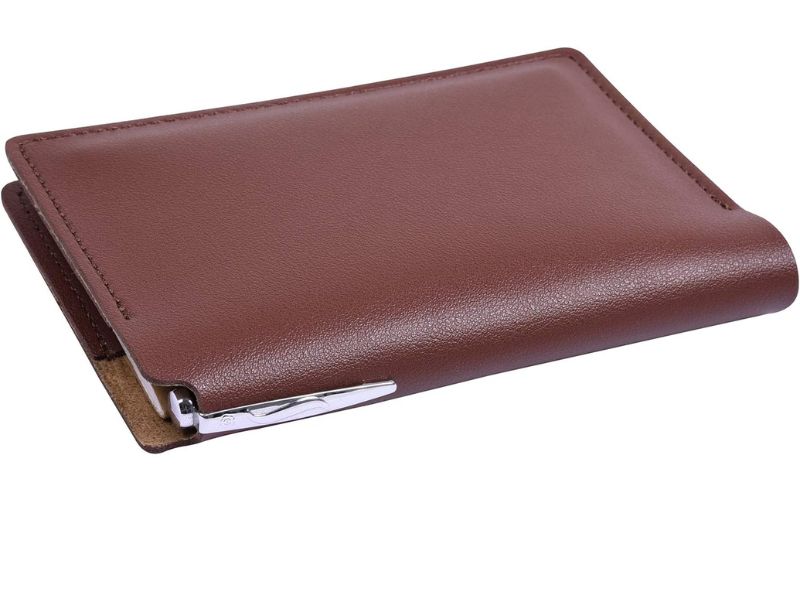
I have a few inquiries regarding PU leather. I would like to learn more about this material and understand its properties and uses.
Is PU leather waterproof?
PU leather is highly water-resistant, meaning that wearing a raincoat made from PU leather will not result in the inner layers getting wet. Additionally, this water-resistant property makes the coat easy to clean by simply wiping it with a damp cloth. However, it is important to note that the coat’s ability to release moisture from the inside is not very effective. Consequently, wearing the coat on hot days may often result in a feeling of stuffiness.
Is PU leather long-lasting and durable? What is the lifespan of PU leather?
PU leather, also known as polyurethane leather, typically has a lifespan of approximately 1 to 2 years. However, it is important to note that this duration can be prolonged or shortened depending on how well the user takes care of the material as well as the frequency of its usage. By properly preserving and maintaining the PU leather, users may be able to extend its usage time beyond the average 1 to 2 years.
Is it better to purchase products made from PU leather or real leather?
When deciding between purchasing PU leather or genuine leather, it is important to carefully consider the advantages and disadvantages of each material. By examining the provided comparison table, you can easily assess the pros and cons associated with each type of leather. Ultimately, the choice between the two depends on the specific evaluation criteria that you prioritize.
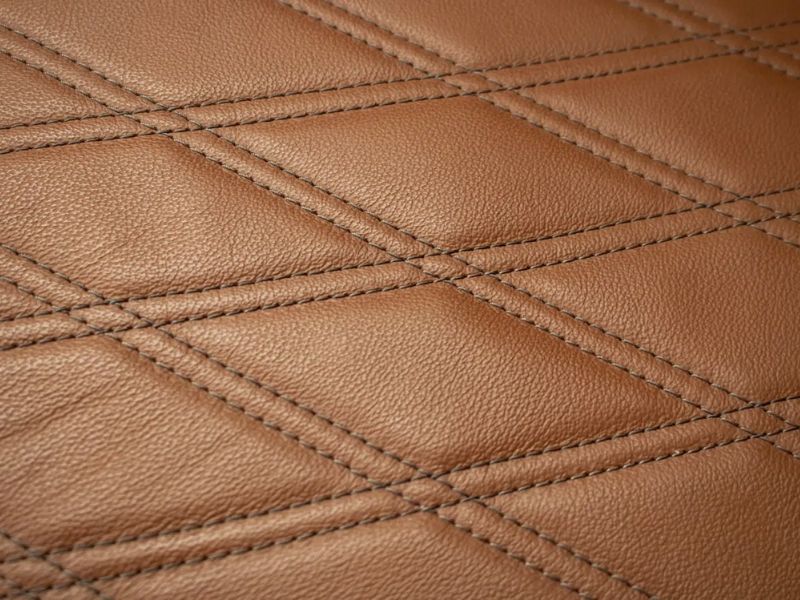
When considering whether to purchase products made from PU leather or genuine leather, there are several factors to take into account. PU leather, also known as faux or synthetic leather, is a man-made material that is designed to mimic the appearance and texture of genuine leather. On the other hand, genuine leather is made from animal hides and is considered to be a natural and durable material.
One important aspect to consider is durability. While genuine leather tends to be more long-lasting and resistant to wear and tear, PU leather products can also be durable with proper care. Genuine leather is known for developing a beautiful patina over time, which adds to its character and appeal. PU leather, on the other hand, may not develop the same patina and may show signs of wear more quickly.
Another factor to consider is cost. Generally, products made from genuine leather are more expensive than those made from PU leather. This is due to the higher cost of sourcing and processing genuine leather. PU leather, being a synthetic material, is often more affordable and can be a viable option for those on a tighter budget.
Ethical considerations may also come into play. Genuine leather is derived from animal hides, which raises concerns for those who are opposed to animal exploitation. In contrast, PU leather is a cruelty-free alternative, making it a more suitable choice for individuals who prioritize ethical sourcing.
Furthermore, personal preferences regarding aesthetics may influence the decision-making process. Genuine leather has a rich and luxurious look that many people admire, while PU leather provides a wide range of color and texture options that may be appealing to others.
Ultimately, the choice between PU leather and genuine leather boils down to personal priorities and preferences. If durability, natural materials, and the development of a patina are important to you, then genuine leather may be the better choice. However, if cost, ethical sourcing, and a wider variety of aesthetic options are your main concerns, then PU leather may be the more suitable option for you.
If you are looking for a product that offers good value for money and falls within a budget of 2,000,000 VND or less, PU leather products are the most ideal choice. However, if you have a larger budget and are seeking luxury, uniqueness, and a soft texture, genuine leather products would be more suitable.
Is PU leather environmentally friendly and safe for human health?
PU leather, also known as polyurethane leather, is a type of vegan leather that is manufactured by coating split leather with polyurethane. This process not only gives the material a similar appearance and texture to genuine leather, but also adds durability and resistance to wear and tear.
One of the key advantages of PU leather is its environmentally friendly nature. Since it is not derived from animal hides, it avoids the ethical concerns associated with traditional leather production. Additionally, the manufacturing process for PU leather has a lower impact on the environment compared to genuine leather production, which involves a complex and resource-intensive tanning process.
Furthermore, PU leather is considered skin-friendly for the majority of people. It is less likely to cause allergies or irritate sensitive skin, making it a suitable alternative for individuals who may have reactions to genuine leather or other synthetic materials. This makes PU leather a versatile option for a wide range of products, including clothing, accessories, furniture, and automotive upholstery.
Overall, PU leather offers a sustainable and humane vegan alternative to traditional leather, providing both a desirable aesthetic and practical advantages.
Fashion Bandung has provided valuable information about PU leather, including its definition and characteristics. They have also discussed the benefits of using PU leather and its various applications. Moreover, the content has emphasized the distinctions between PU leather and genuine animal leather. In case you have any inquiries regarding this material, Fashion Bandung encourages you to reach out to them for comprehensive responses.
Fashion Bandung is a brand that specializes in providing high-quality fashion options for men. With a focus on stylish and trendy clothing, Fashion Bandung aims to offer customers a wide range of options to suit their individual preferences and style. From casual attire to formal wear, Fashion Bandung is committed to delivering garments that are not only fashionable but also made to last. With attention to detail and a focus on quality, Fashion Bandung ensures that customers can confidently express their personal style while looking their best.

Editor: Dao Mai Trang is a highly skilled and experienced editor with a keen eye for detail and a passion for delivering high-quality work. With a strong command of the English language and exceptional attention to grammar, syntax, and punctuation, Dao Mai Trang is committed to ensuring that every written piece meets the highest standards of clarity and coherence. With a professional background in editing various genres, including academic papers, articles, and creative writing, Dao Mai Trang possesses the ability to provide constructive feedback and suggestions while maintaining the author’s unique voice. With a meticulous approach to editing, Dao Mai Trang diligently highlights any inconsistencies, errors, or areas of improvement in order to enhance the overall readability and impact of the text. As an editor, Dao Mai Trang’s primary objective is to help authors effectively communicate their ideas and ensure that their work is polished and professional.

